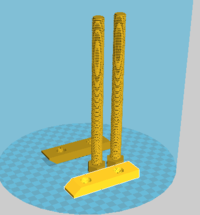| Line 1: | Line 1: | ||
{{242}} | {{242}} | ||
== Bee Feeder == | == Bee Feeder == | ||
Project developed by [[User:Thebcm27|user | Project developed by [[User:Thebcm27|user: Bjorn Mathisen]] | ||
{{Statusboxtop}} | {{Statusboxtop}} | ||
{{status-design}} | {{status-design}} | ||
Revision as of 13:53, 10 April 2017
Bee Feeder
Project developed by user: Bjorn Mathisen
Template:Statusboxtop Template:Status-design Template:Status-prototype You can help Appropedia by contributing to the next step in this OSAT's status. Template:Boxbottom
Abstract
- It is spring. And that means your friendly honeybees may be running low on their stored honey reserves, but what to do before the flowers start blossoming? Do you leave them to starve in the harsh springtime? Or do you feed them with your very own sugar water bee feeder!

Bill of Materials
- Regular canning mason jar
- 3D printed bee feeder device
- 1/4 2" mounting screws
Tools needed for fabrication of the OSAT
- Jellybox or similar RepRap 3-D printer
- Screwdriver for mounting to surface
Skills and Knowledge Necessary to Make the OSAT
- If you used special skill – link to relevant wikipedia or wikiversity articles/courses
Technical Specifications and Assembly Instructions
- Provide directions for print/assembly - be detailed enough in your “how to” to ensure that someone could construct the device from your description. Consider the elegance of IKEA like instructions.
- Include print time estimate
- Include assembly time estimate
- Including drawings or pictures of the device at stage of assembly at minimum. (http://www.appropedia.org/Special:Upload)
- Consider video if appropriate
| Example video summary of textbook |
|---|
Error in widget YouTube: Unable to load template 'wiki:YouTube' |
Common Problems and Solutions
- Include common mistakes/problems to avoid in building your OSAT and how to overcome them
Cost savings
- If your solution is not a low cost one then it is not really appropriate.
- Estimate your costs
- Find a commercial equivalent
- Calculate $ savings and % savings
References
- The sources of information (e.g. engineering handbooks, journal articles, government documents, webpages, books, magazine articles etc.). References should use the <ref> </ref> and <references/> tags and can be in any format but should include all the information necessary for someone else to find the same information you did. For example: [1]
- ↑ web page: Department of Energy (DOE) Landscaping and Energy Efficiency, DOE/GO-10095 (1995) Available: http://www.eren.doe.gov/erec/factsheets/landscape.html
Based on the developmental needs addressed (e.g. food, heat, electricity, clean water, health care, etc.) be sure to label your device in the proper categories e.g. use [[Category:Water]]. Be sure to categorize your device so that it will be easy to find – for example “Low voltage connection basics” is categorized in. [[Category:How tos]] [[Category:Electricity]] [[Category:Electric lighting]].